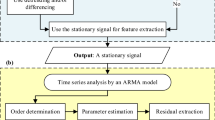Abstract
Vibration-based methods for damage localizations often rely on a damage feature defined in terms of changes of modal shapes and localize damage by detecting shape irregularities that are ascribed to local loss of stiffness. In this paper, the performance of several algorithms for damage localization is investigated and the results are compared in terms of the gain of information they provide, which is measured by the relative information entropy also known as Kullback–Leibner (KL) divergence. This parameter is a measure of the difference between two probability distributions and can quantify the information gain achieved using different statistical models. In this paper the relative entropy is used to compare the gain of information obtained using different damage-sensitive indicators retrieved from simulated structural health monitoring data. The investigation is carried out using structural responses simulated using the finite element model of a real bridge permanently monitored by the Italian Seismic Observatory of Structures.














Similar content being viewed by others
References
Toksoy T, Aktan AE (1994) Bridge-condition assessment by modal flexibility. Exp Mech 34:271–278
Cruz PJS, Salgado R (2009) Performance of vibration-based damage detection methods in bridges. Comput Aided Civil Infrastruct Eng 24:62–79
Necati Catbas F, Gul M, Burkett JL (2008) Conceptual damage-sensitive features for structural health monitoring: laboratory and field demonstrations. Mech Syst Signal Process 22:1650–1669
Magalhães F, Cunha A, Caetano E (2012) Vibration based structural health monitoring of an arch bridge: from automated OMA to damage detection. Mech Syst Signal Process 28:212–228
Kato M, Shimada S (1986) Vibration of PC bridge during failure process. J Struct Eng ASCE 112:1692–1703
Farrar CR, Jauregui DA (1998) Comparative study of damage identification algorithms applied to a bridge: I. Experiment. Smart Mater Struct 7:704–719
Maek J, Peeters B, De Roeck G (2001) Damage identification on the Z24 bridge using vibration monitoring. Smart Mater Struct 10:512–517
Dilena M, Limongelli MP, Morassi A (2014) Damage localization in bridges via FRF interpolation method. Mech Syst Signal Process 52–53:162–180
Limongelli MP, Tirone M, Surace C (2017) Non destructive monitoring of a prestressed bridge with a data-driven. In: Proceedings of SPIE 10170, health monitoring of structural and biological systems 2017, 1017033. https://doi.org/10.1117/12.2258381
Rainieri C, Gargaro D, Fabbrocino G, Maddaloni G, Di Sarno L, Prota A, Manfredi G (2018) Shaking table tests for the experimental verification of the effectiveness of an automated modal parameter monitoring system for existing bridges in seismic areas. Struct Control Health Monit 25:e2165
Salawu OS (1997) Detection of structural damage through changes in frequency: a review. Eng Struct 19(9):718–723
Worden K, Inman DJ (2010) Modal vibration methods in Structural Health Monitoring. In: Blockley R, Shyy W (eds) Encyclopedia of aerospace engineering. Wiley, pp 1995–2004
Pandey A, Biswas M, Samman M (1991) Damage detection from changes in curvature mode shapes. J Sound Vib 145(2):321–332
Pandey A, Biswas M (1994) Damage detection in structures using changes in flexibility. J Sound Vib 169(1):3–17
Stubbs N, Kim JT, Topole K (1992) An efficient and robust algorithm for damage localization in offshore platforms. In: Proceedings of the ASCE tenth structures congress, pp 543–546
Alvandi A, Cremona C (2006) Assessment of vibration-based damage identification techniques. J Sound Vib 292:179–202
Limongelli MP, Fathi A (2018) The interpolation method for vibration based damage localization: influence of feature uncertainties. In: Powers N, Frangopol DM, Al-Mahaidi R, Caprani C (eds) Maintenance, safety, risk, management and life-cycle performance of bridge. Taylor & Francis Group, London, pp 953–960
Shannon C (1948) A mathematical theory of communication. Bell Syst Tech J 27:379–423, 623–656
Jalayer F, Beck JL, Zareian F (2012) Analyzing the sufficiency of alternative scalar and vector intensity measures of ground shaking based on information theory. J Eng Mech 138(3):307–316
Capellari G, Chatzi E, Mariani S (2018) Cost–benefit optimization of structural health monitoring sensor networks. Sensors 18(7):2174
Limongelli MP (2011) The interpolation damage detection method for frames under seismic excitation. J Sound Vib 330:5474–5489
Trefethen L (2013) Approximation theory and approximation practice. Society for Industrial and Applied Mathematics, Philadelphia
Ahlberg J, Nilson E, Walsh (1967) The theory of spline and their applications. Academia Press, Cambridge
Dolce M, Nicoletti M, De Sortis A, Marchesini S, Spina D, Talanas F (2017) Osservatorio sismico delle strutture: the Italian structural seismic monitoring network. Bull Earthq Eng 15:621–641
Italian Ministry of Infrastructures and Transport (2018) D.M. 17/10/2018. Aggiornamento delle «Norme tecniche per le costruzioni», Gazzetta Ufficiale, n. 42 del 20/02/2018 - Suppl. Ordinario n. 8. (In Italian)
C.S.LL.PP. (2009) Circular 617: Istruction document to the Italian Code for Structural Design. Official Bulletin n. 617 of February 2, 2009
Quqa S, Landi L, Diotallevi PP (2018) On the use of singular vectors for the flexibility-based damage detection under the assumption of unknown structural masses. Shock vib 2018:9837694
Tondreau G, Deraemaeker A (2014) Numerical and experimental analysis of uncertainty on modal parameters estimated with the stochastic subspace method. J Sound Vib 333:4376–4401
Acknowledgements
The availability of ambient vibration data for the studied bridge, provided by the Italian Seismic Observatory of structures is gratefully acknowledged. This study was partially funded by the Italian Civil Protection Department within the project DPC-RELUIS 2016—RS4 “Seismic observatory of structures and health monitoring”.
Author information
Authors and Affiliations
Corresponding author
Additional information
Publisher's Note
Springer Nature remains neutral with regard to jurisdictional claims in published maps and institutional affiliations.
Rights and permissions
About this article
Cite this article
Limongelli, M., Giordano, P. Vibration-based damage indicators: a comparison based on information entropy. J Civil Struct Health Monit 10, 251–266 (2020). https://doi.org/10.1007/s13349-020-00381-9
Received:
Revised:
Accepted:
Published:
Issue Date:
DOI: https://doi.org/10.1007/s13349-020-00381-9




